B
(or B-Movie, B-Picture) |
an off-beat, low-budget, second-tier film, usually from an independent producer; they were predominant from the 1920s to the late 1940s; they were shot quickly with little-known, second rate actors, short run times, and low production values; often the second film (or the 'lower half') of a double-feature, and paired with an A-feature; the vintage B-movie began to decrease in the 50s, or morphed into inferior TV series; sometimes B-films were exclusively shown in a grindhouse, especially in the 50s and 1960s; as code restrictions waned in the late 60s, B-films often became exploitation films, which added sensational and catchy titles, campy acting, cheesy special effects, and gratuitous violence and sexuality (nudity); contrast to A-pictures (first-class, big-budget films with high-level production values and star-power); not to be confused with cult films, although some B-films attained cult status |
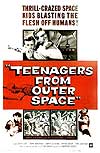 Examples: John Wayne (Roy Rogers, Gene Autry, B-westerns, B-movie serials, Fox's Charlie Chan mysteries, Monogram's Bowery Boys comedies, and Universal's Ma and Pa Kettle and Sherlock Holmes, The Ghost of Frankenstein (1942), a typical low-budget, sci-fi B-movies of the 50s - The Beast with 1,000,000 Eyes (1955), and Teenagers From Outer Space (1959); also Edgar G. Ulmer's Detour (1945). Examples: John Wayne (Roy Rogers, Gene Autry, B-westerns, B-movie serials, Fox's Charlie Chan mysteries, Monogram's Bowery Boys comedies, and Universal's Ma and Pa Kettle and Sherlock Holmes, The Ghost of Frankenstein (1942), a typical low-budget, sci-fi B-movies of the 50s - The Beast with 1,000,000 Eyes (1955), and Teenagers From Outer Space (1959); also Edgar G. Ulmer's Detour (1945). |
| refers to a large photographic backing or painting for the background of a scene (e.g., a view seen outside a window, a landscape scene, mountains, etc.), usually painted on flats (composed of plywood or cloth); a large curved backdrop (often representing the sky) is known as a cyclorama; backdrops were more commonly used before the current trend toward on-location shooting and the use of bluescreens. | 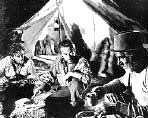 Example: although filmed on location in Mexico, most of the night scenes in The Treasure of the Sierra Madre (1948) were filmed on a studio set, with backdrops or flats. Example: although filmed on location in Mexico, most of the night scenes in The Treasure of the Sierra Madre (1948) were filmed on a studio set, with backdrops or flats. |
|
| refers to anything occuring in a rear plane of action(the background as opposed to the main action or attention in the foreground); abbreviated as b.g. | ||
| the individual who designs the visual background of a film scene, either traditionally painted or using digital technology; aka matte artist | ||
| refers to part of the score that accompanies a scene or action in a film, usually to establish a specific mood or enhance the emotion. | ||
| this phenomenon occurs when the lighting for the shot is directed at the camera from behind the subject(s), causing the figure(s) in the foreground to appear in semi-darkness or as silhouettes, or highlighted; with backlighting, the subject is separated from the background |
|
|
| an undeveloped area, on studio property, in an open-air, outdoor space away from the studio stages, where real-life situations with backgrounds can be filmed; contrasted to on-location shoots that are more expensive; various studios in the Los Angeles area offer back lot tours. |
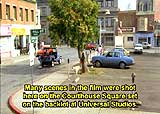 Examples: big-city intersections, western streets are often filmed on back lots; above is the backlot of Universal Studios where some scenes were shot for Back to the Future (1985) Examples: big-city intersections, western streets are often filmed on back lots; above is the backlot of Universal Studios where some scenes were shot for Back to the Future (1985) |
|
| a photographic technique whereby live action is filmed in front of a transparent screen onto which background action is projected. Back projection was often used to provide the special effect of motion in vehicles during dialogue scenes, but has become outmoded and replaced by bluescreen (or greenscreen) processing and traveling mattes; also known as rear projection or process photography (or shot); contrast to matte shot. |
 Examples: Any film with a moving vehicle and back-projected street scenes viewed through the back or side windows, such as in To Catch a Thief (1955). Examples: Any film with a moving vehicle and back-projected street scenes viewed through the back or side windows, such as in To Catch a Thief (1955). |
|
| refers to the events that directly happened prior to the beginning of the story, or lead to the story; composed of information that helps fill out the skeletal story of a screenplay or a character's background, often to help actors (or the audience) understand motivation. |  Example: the beginning of Casablanca (1942) provides back story about the war, the locale of the film, etc.; a reversal of back story is found in Memento (2000) Example: the beginning of Casablanca (1942) provides back story about the war, the locale of the film, etc.; a reversal of back story is found in Memento (2000) |
|
| within a film's visual frame, refers to the composition, aesthetic quality, or working together of the figures, light, sound, and movement. |  Example: from Sunset Boulevard (1950), a beautifully balanced and composed frame Example: from Sunset Boulevard (1950), a beautifully balanced and composed frame |
|
| the blocking of a film's release (in a theatre showing or on video) by either the government or an official movie classification board, for political, religious, sexual, or social reasons; see also censorship. |
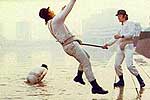 Examples: director Stanley Kubrick voluntarily banned his own film A Clockwork Orange (1971) in Britain for almost 30 years because of copy-cat violence. And recently, the Academy award-winning film The Tin Drum (1979) was seized and declared obscene by state law in Oklahoma. Examples: director Stanley Kubrick voluntarily banned his own film A Clockwork Orange (1971) in Britain for almost 30 years because of copy-cat violence. And recently, the Academy award-winning film The Tin Drum (1979) was seized and declared obscene by state law in Oklahoma. |
|
| the black metal folding doors an all four sides of a light that can be bent back and forth on their hinges to control where the light is directed. |  Lighting with Barn Doors |
|
| a blanket placed over the film camera to reduce the amount of noise of the moving mechanisms inside; see also blimp. | ||
| films that consist of a story line that has at least some basis in real historical events, and may actually contain only a few factual elements. These films, loosely based on various biographies, stories, or events, may/may not significantly alter the characters or situations for greater dramatic effect; inspired by a true story indicates the film is even looser with the factual basis of the events. |
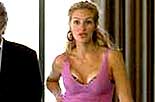 Examples: Braveheart (1995) (an account of the life of medieval Scottish patriot William Wallace), Raging Bull (1980)(based on the life of middleweight boxer Jake LaMotta), and Erin Brockovich (2000) (with Julia Roberts as the crusading single mother) shown here. Examples: Braveheart (1995) (an account of the life of medieval Scottish patriot William Wallace), Raging Bull (1980)(based on the life of middleweight boxer Jake LaMotta), and Erin Brockovich (2000) (with Julia Roberts as the crusading single mother) shown here. |
|
| refers to an actor's term for how long to wait or pause before doing an action; a beat is usually about one second; a "beat" is often interchangeable with a narrative device in a script known as an ellipse (designated in the text as "...") | ||
| the off-camera events or circumstances during filmmaking. |  Example: The documentary Hearts of Darkness: A Filmmaker's Apocalypse (1991) chronicled the sensational, behind-the scenes circumstances during the making of Francis Ford Coppola's Apocalypse Now (1979). Example: The documentary Hearts of Darkness: A Filmmaker's Apocalypse (1991) chronicled the sensational, behind-the scenes circumstances during the making of Francis Ford Coppola's Apocalypse Now (1979). |
|
| includes production expenses that are not above the line, such as costs of material, music rights, publicity, the trailer; opposite of above the line | ||
| the term for any technical assistant, apprentice or aide (regardless of sex) for the gaffer or the (key) grip on a set, responsible for the routing and coiling of power cables necessary to run the lights for a shot; also the 'best boy' schedules the people and equipment needed for a day's work; a gender-neutral term that came from whaling; aka Assistant Chief Lighting | ||
| 1/2 inch videotape that was originally called Betamax. |  Betamax cassette tape box |
|
| the placement or display of names of actors, directors, and producers for a movie in publicity materials, opening (or closing) film credits, and on theatre marquees. A person's status is indicated by the size, relative position, and placement of their name. Generally, higher positions closer to the top with larger and more prominent letters designate higher importance and greater box-office draw, and precede people of lesser importance; the most prominent actor that appears first is said to have top billing, followed by second billing, and so forth. | 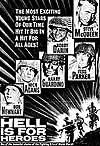 Example: Notice top billing given to Steve McQueen in Hell is for Heroes (1962). Example: Notice top billing given to Steve McQueen in Hell is for Heroes (1962). |
|
(or biographic) |
a biographical film of the life of a famous personality or historical figure, particularly popularized by Warner Bros. in the 1930s; a sub-genre of drama and epic films. |  Examples: The Story of Louis Pasteur (1936), or The Life of Emile Zola (1937), or the modern day Coal Miner's Daughter (1980) about Loretta Lynn. Examples: The Story of Louis Pasteur (1936), or The Life of Emile Zola (1937), or the modern day Coal Miner's Daughter (1980) about Loretta Lynn. |
(or bit player) |
a small acting role (usually only one scene, such as a waiter) with very few lines or acting; contrast to a cameo, extra, or walk-on role. | Example: Roger Corman making a brief appearance in The Godfather, Part II (1974) at the head table at Michael Corleone's Senate hearings. |
| in shorthand, refers to the "business", or "show business". | ||
| simply means without color; before the invention of color film stock, all films were black and white; monochrome (literally meaning "one color") usually refers to a film shot in black and white, although it can refer to a film shot in shades of one color; grainy B&W is often used to convey authenticity; abbreviated as BW, B/W, and B&W; contrast to color. |  Example: For artistic reasons, Peter Bogdanovich's The Last Picture Show (1971) was purposely made in B&W. Example: For artistic reasons, Peter Bogdanovich's The Last Picture Show (1971) was purposely made in B&W. |
|
| a type of comedy film, first popular during the late 1950s and early 1960s in which normally serious subjects, such as war, death, dismemberment, misery, suffering, or murder, are treated with macabre humor and satire through iconography, dialogue, and the characters; settings may include cemeteries, war rooms, funerals |
 Examples: Hitchcock's The Trouble With Harry (1955), Dr. Strangelove, Or: How I Learned to Stop Worrying and Love the Bomb (1964), The Loved One (1965), Robert Altman's M*A*S*H (1970), Harold and Maude (1972), Monty Python and the Holy Grail (1975), Whatever Happened to Baby Jane? (1962), Prizzi's Honor (1985), Heathers (1989), and Fargo (1996). Examples: Hitchcock's The Trouble With Harry (1955), Dr. Strangelove, Or: How I Learned to Stop Worrying and Love the Bomb (1964), The Loved One (1965), Robert Altman's M*A*S*H (1970), Harold and Maude (1972), Monty Python and the Holy Grail (1975), Whatever Happened to Baby Jane? (1962), Prizzi's Honor (1985), Heathers (1989), and Fargo (1996). |
|
(and blacklist) |
refers to late 40s and early 50s McCarthyism and the HUAC's (House UnAmerican Activities Committee) formal and informal discrimination and 'blacklisting' (effectively banning from employment) of various actors, artists and film-makers based upon their personal, political, social, or religious beliefs (i.e., "Communist sympathizers"); the blacklist was a roster of illegal artists who were not to be hired during the years 1947-1951. |  The Hollywood Ten were a group of playwrights and moviemakers who refused to answer questions claiming their First Amendment rights, and were charged with contempt - they included Herbert Biberman, Lester Cole, Albert Maltz, Adrian Scott, Samuel Ornitz, Dalton Trumbo, Edward Dmytryk, Ring Lardner Jr., John Howard Lawson, and Alvah Bessie; also informally blacklisted recently were Jane Fonda and Vanessa Redgrave for outspoken attitudes The Hollywood Ten were a group of playwrights and moviemakers who refused to answer questions claiming their First Amendment rights, and were charged with contempt - they included Herbert Biberman, Lester Cole, Albert Maltz, Adrian Scott, Samuel Ornitz, Dalton Trumbo, Edward Dmytryk, Ring Lardner Jr., John Howard Lawson, and Alvah Bessie; also informally blacklisted recently were Jane Fonda and Vanessa Redgrave for outspoken attitudes |
| a combination of the terms "black" and "exploitation"; refers mainly to sensational, low-budget films in the 1970's featuring mostly African-American casts (and directors), that broke the mold of black characterization in feature films; usually emphasized fads of the time in hairstyles, music and costuming, and also brutality, sleazy sex, street-life, racist and militant attitudes, etc. | 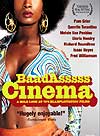 Examples: Sweet Sweetback's Badasssss Song (1971), Superfly (1972), and Ralph Bakshi's animated Coonskin (1975); a documentary titled Baadasssss Cinema (2003) from the Independent Film Channel by filmmaker Isaac Julien examined the early 70s and the phenomenon of blaxploitation films Examples: Sweet Sweetback's Badasssss Song (1971), Superfly (1972), and Ralph Bakshi's animated Coonskin (1975); a documentary titled Baadasssss Cinema (2003) from the Independent Film Channel by filmmaker Isaac Julien examined the early 70s and the phenomenon of blaxploitation films |
|
| used to refer to Britain | ||
| the sound-deadening housing a noisy movie camera is put in to prevent the recording of extra sounds by the camera's motor or sound equipment | ||
| originally referred to a large bomb that would destroy an entire city block during World War II; now in common usage, an impactful movie that is a huge financial success - usually with box-office of more than $200 million (the new benchmark by the early 2000s, after the original mark was $100 million) upon release in North America; ticket lines for blockbusters literally go around the 'block'; also known as box-office hit; the term may also refer to a costly film that must be exceptionally popular in order to recoup its expenses and make a profit; the opposite of a blockbuster is a bomb, flop, or turkey. See All-Time Box-Office Bombs/Flops. | 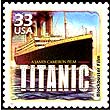 Examples: The term was first applied to Steven Spielberg's Jaws (1975), often acknowledged as the first blockbuster; James Cameron's Titanic (1997) was also a massive blockbuster hit. See All-Time Top 100 Box-Office Hits. Examples: The term was first applied to Steven Spielberg's Jaws (1975), often acknowledged as the first blockbuster; James Cameron's Titanic (1997) was also a massive blockbuster hit. See All-Time Top 100 Box-Office Hits. |
|
| the process of figuring out where the camera goes, how the lights will be arranged, and what the actors' positions and movements - moment by moment - are for each shot or take; often, the specific staging of a film's movements are worked out by the director, often with stand-ins and the lighting crew before actual shooting | ||
| an actual error or mistake (misplaced action, or mis-spoken dialogue by a performer), usually embarrassing or humorous, made by a performer during filming; also known as a goof, flaw or flub; see also continuity |  Examples: in Jurassic Park (1993), the name of a common dinosaur (Stegosaurus) was spelled incorrectly; in the cafeteria scene at Mt. Rushmore in North by Northwest (1959), a boy extra in the cafeteria of Mt. Rushmore plugs his ears before a gun goes off; Examples: in Jurassic Park (1993), the name of a common dinosaur (Stegosaurus) was spelled incorrectly; in the cafeteria scene at Mt. Rushmore in North by Northwest (1959), a boy extra in the cafeteria of Mt. Rushmore plugs his ears before a gun goes off;  or in The Invisible Man (1933)when Claude Rains strips to avoid police, he leaves visible shoe prints in the snow; probably the most frequent flub in films is the appearance of the boom mike or in The Invisible Man (1933)when Claude Rains strips to avoid police, he leaves visible shoe prints in the snow; probably the most frequent flub in films is the appearance of the boom mike |
|
| an optical process - the enlargement of a photographic image or film frame; often used to create 70mm release prints from original 35mmfilms |
|
|
or blue-screen shot |
a special-effects process whereby actors work in front of an evenly-lit, monochromatic (usually blue or green) background, screen, or backdrop. The background is then replaced (or matted) in post-production by chroma-keying or optical printer, allowing other footage or computer-generated images (CGI) to form the background image; since 1992, most films use a green-screen |  Example: a bluescreen for Jurassic Park III (2001), or greenscreen for Charlie's Angels (2000)  |
| another name for a commercial or advertisement (usually for TV) | ||
(or double) |
a performer who takes the place of an actor in scenes that require a close-up of body parts without the face visible, often for nude scenes requiring exposed close-ups (considered distasteful by some actors), or scenes requiring physical fitness; not to be confused with stunt double or stand-in |
 Example: Marli Renfro, a hired double for Janet Leigh for test scenes in the shower scene in Psycho (1960). Example: Marli Renfro, a hired double for Janet Leigh for test scenes in the shower scene in Psycho (1960). |
| refers to the burgeoning film industry of India, the world's biggest film industry, centered in Bombay (now Mumbai); the etymology of the word: from Bo(mbay) + (Ho)llywood; unlike Hollywood, however, Bollywood is a non-existent place. |
 Example: Mira Nair's Monsoon Wedding (2001), a modern Indian film set in current-day New Delhi, echoes the Bollywood spirit with typical traits including music and dance, romance, and comedy. Also the Best Picture winning Slumdog Millionaire (2008). Example: Mira Nair's Monsoon Wedding (2001), a modern Indian film set in current-day New Delhi, echoes the Bollywood spirit with typical traits including music and dance, romance, and comedy. Also the Best Picture winning Slumdog Millionaire (2008). |
|
| a term denoting scenes at the beginning and end of a film that complement each other and help tie a film together; aka framing device | 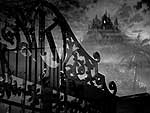 Example: the view of Xanadu's gate in Citizen Kane (1941) Example: the view of Xanadu's gate in Citizen Kane (1941) |
|
| a traveling or moveable counter-balanced pole (also called fishpole or fishing rod), arm, or telescoped extension device upon which a microphone, light or camera can be suspended overhead above a scene and outside the frame during filming (by a boom operator or boom man); for example, a microphone (mike) boom, a camera boom, or a light boom; the most common film mistake is the appearance of the boom mike (or its shadow) in the frame; a mechanical boom mike is known as a 'giraffe.' |
 Example: A microphone boom stand from the late 40s |
|
| a continuous single shot made from a moving boom, assembled like a montage, and incorporating any number of camera levels and angles. |  Example: Hitchcock used this filming technique for almost all of Rope (1948). Example: Hitchcock used this filming technique for almost all of Rope (1948). |
|
| an illegally copied, unauthorized, and/or distributed version of a copyrighted film/video/DVD, often of second-rate quality; also termed pirated. |
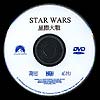 Example: a bootlegged DVD version of Star Wars (1977), mastered using an Asian release of the special edition laserdisc. |
|
| refers to a device to reflect light during filming; the board is usually a large white surface made of foam or poster board | ||
| refers to purging anything considered disturbing, vulgar, or adult in content in order to make it sanitized for mass market consumption and appropriate for children; originally a literary term derived from the name of Englishman Thomas Bowdler who published a 'censored' Family Shakespeare version in the early 1800s. | Examples: Cat on a Hot Tin Roof (1956) removed the stage play's references to homosexuality; Disney's Snow White and the Seven Dwarfs (1937)was a 'bowdlerized,' prudish and sterilized version of the original Grimm fairy tale, with darker and more adult content | |
| the measure of the total amount of money or box-office receipts paid by movie-goers to view a movie; also referred to as B. O. or gross; usually divided into domestic grosses (unadjusted and adjusted for inflation), and worldwide grosses; films with great box-office results or a strong and outstanding performance are often termed 'boff', 'boffo', 'boffola', 'whammo', 'hotsy', or 'socko'. |  |
|
| the act of shooting a scene several times with different F-stops to try and get a certain desired effect | ||
| a transitional type of shot used to cover or 'bridge' a jump in time or place or other discontinuity; see also audio bridge and match-cut |
 Examples of bridging shots include: falling calendar pages, newspaper headlines, railroad wheels, seasonal changes, and maps, such as the transitional travel maps (reminiscent of serials) in Raiders of the Lost Ark (1981) Examples of bridging shots include: falling calendar pages, newspaper headlines, railroad wheels, seasonal changes, and maps, such as the transitional travel maps (reminiscent of serials) in Raiders of the Lost Ark (1981) |
|
| a subgenre of film (comedies, westerns, dramas, action films, road films, etc.) in which two mismatched persons (usually males) are forced to work together, often a pair of police cops; situations are often contrived to present the pair with challenges or strains that both strengthen their bond and weaken it; buddy films are often action/comedy films with witty dialogue between the two characters and sometimes the inclusion of a love triangle; has been extended to include female buddies; compare to fish-out-of-water tale | 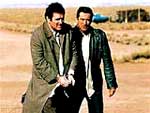 Examples: The Defiant Ones (1958), Butch Cassidy and the Sundance Kid (1969), Midnight Cowboy (1969), 48 HRs (1984), Lethal Weapon (1987), Midnight Run (1988) (pictured), Thelma & Louise (1991), Unforgiven (1992), Wayne's World (1992), Dumb and Dumber (1994), Leon (or The Professional) (1994), The Shawshank Redemption (1994), Men in Black (1997) Examples: The Defiant Ones (1958), Butch Cassidy and the Sundance Kid (1969), Midnight Cowboy (1969), 48 HRs (1984), Lethal Weapon (1987), Midnight Run (1988) (pictured), Thelma & Louise (1991), Unforgiven (1992), Wayne's World (1992), Dumb and Dumber (1994), Leon (or The Professional) (1994), The Shawshank Redemption (1994), Men in Black (1997) |
|
| using dramatic devices such as increased tempo, volume, and emphasis to bring a scene to a climax | ||
| usually refers to the pre-film segment of pre-made film that contains studio trademark and logo or title identification; also refers to a period of positive financial growth (i.e., it was a 'bumper year' for films) | 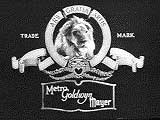 Examples: MGM's lion, Universal's spinning globe, DreamWorks' cloudy scene with boy fishing, etc. Examples: MGM's lion, Universal's spinning globe, DreamWorks' cloudy scene with boy fishing, etc. |
|
| slang for the sense of excitement, expectancy, and hype that surrounds a film, an actor, or a director | ||
| a soundtrack of natural, atmospheric, on-location background noise that is added to the re-recorded (or looped) track of actors' dialogue and other sound effects recordings to create a more realistic sound; aka referred to as room tone or matching ambient sound; a wild track or sound refers to a soundtrack w/o any synchronized picture accompanying it (e.g., the sounds of a playground) | ||
źródło:www.filmsite.org
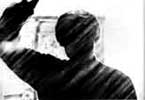 Examples: Hitchcock's
Examples: Hitchcock's 
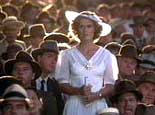
 Examples:
Examples: